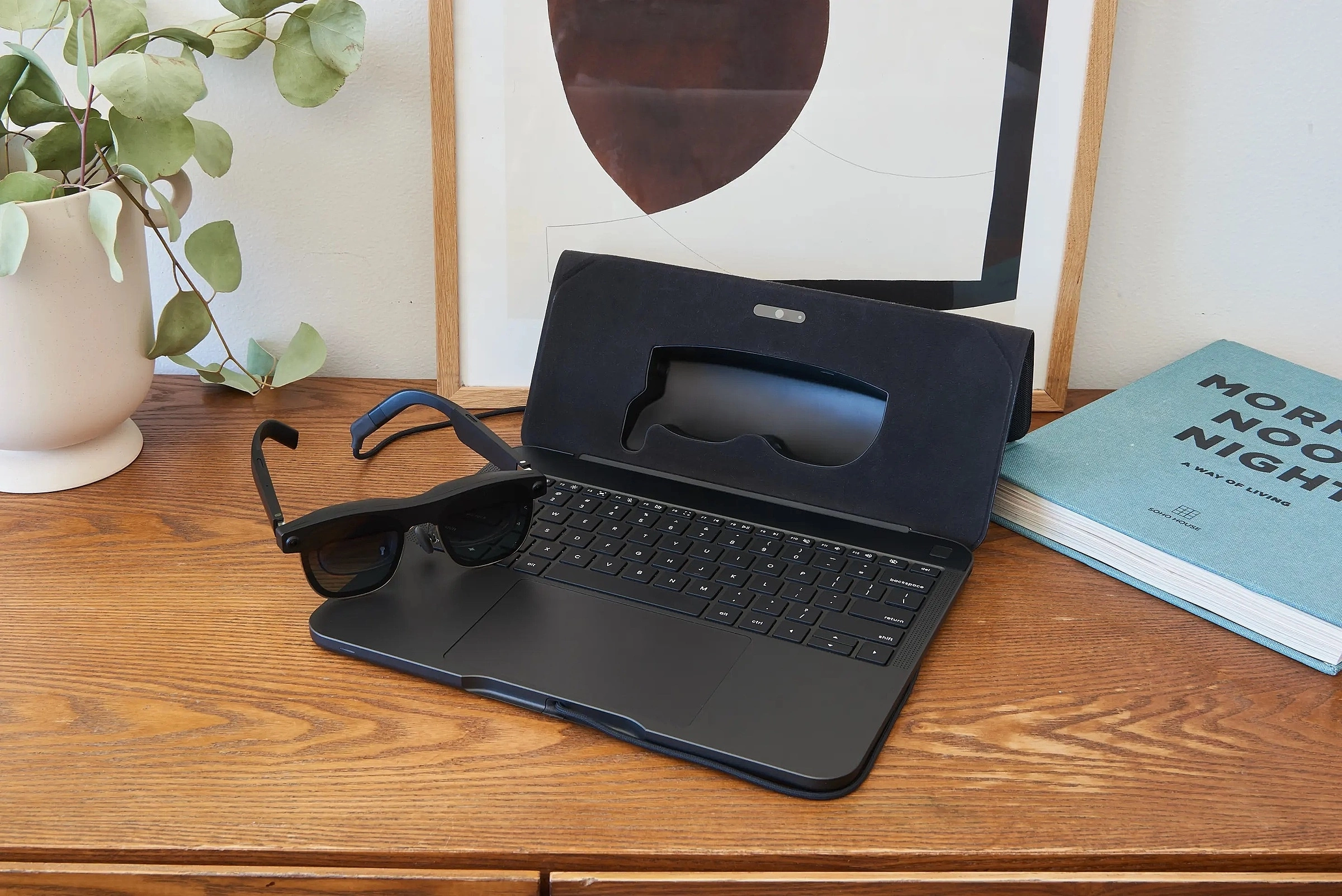What is Spacetop, and how does it work?
Have you ever wished you could replace your laptop screen with something much larger? Well, an Israeli startup called Visionful might have just what you’re looking for. They’ve developed a new type of laptop called Spacetop that utilizes augmented reality (AR) glasses to project a 100-inch virtual screen directly in front of your eyes.
Imagine working on a massive screen without having to hunch over a tiny laptop display. That’s the idea behind Spacetop. Instead of a traditional laptop screen, you’ll wear a pair of AR glasses that project a virtual screen that appears to float in front of you. You can interact with this virtual screen, just like you would with a regular laptop screen, using the keyboard and mouse.
Here’s a closer look at how Spacetop works:
- Virtual Screen: Visionful says the virtual screen will adjust its position based on your movements, thanks to a built-in motion-tracking camera. This feature, however, wasn’t available in the first-generation model. Instead, users had to use the mouse to drag the screen around according to their eye position.
- AR Glasses: The entire system is housed within the AR glasses. These glasses are equipped with a powerful processor, 16GB of RAM, and 128GB of storage. They also support 5G connectivity, Wi-Fi 7, and Bluetooth 5.3. The battery lasts up to 8 hours on a single charge and has two USB-C ports for connecting peripherals.
- Software: Spacetop runs a specialized operating system called Space OS, which is optimized for spatial computing. It also comes with a 5-megapixel webcam built into the AR glasses for video conferencing.
Technical Specifications of Spacetop Gen 1
The first-generation Spacetop (Spacetop Gen 1) is packed with some impressive tech. Here’s a quick rundown of its key specifications:
- Processor: Snapdragon QCS8550 chip with KRYO CPU and Adreno 740 graphics supporting AI processing
- Memory: 16 GB LPDDR5 RAM
- Storage: 128 GB internal memory
- Connectivity: 5G, Wi-Fi 7, Bluetooth 5.3
- Battery: 60 Wh battery lasting 8 hours per charge
- Ports: 2x USB-C ports
- Camera: 5 MP webcam
- AR Glasses:
- Weight: 85g
- Display: OLED screen with FullHD resolution, 90Hz refresh rate, 50-degree viewing angle
- Audio: Speakers and a microphone on each side of the glasses
Benefits of using Spacetop Gen 1
There are several potential benefits to using Spacetop Gen 1:
- Considerable Screen Experience: The most apparent benefit is the ability to work on a massive 100-inch virtual screen. This can be a game-changer for tasks such as graphic design, video editing, or simply browsing the web. No more squinting at a tiny laptop screen!
- Improved Posture: Hunching over a small laptop screen can lead to neck and back pain. With Spacetop, you can maintain a more ergonomic posture since the virtual screen appears in front of you, eliminating the need to bend forward.
- Portability: Despite the large virtual screen, Spacetop itself is pretty portable. The AR glasses and a separate keyboard are all you need to set up your workstation anywhere. This can be a significant advantage for individuals who frequently travel for work.
- Privacy: Since the virtual screen only appears to you through the AR glasses, others nearby won’t be able to see what you’re working on. This can be a plus for those who work with sensitive information.
- AR Integration: Spacetop Gen 1 is built on an operating system designed for spatial computing, which means it has the potential to integrate seamlessly with future AR applications. This opens up exciting possibilities for using AR in new and innovative ways.
However, it’s essential to consider some potential limitations before jumping on the Spacetop bandwagon. We’ll explore those in the next section.

Potential Limitations of Spacetop Gen 1
While Spacetop Gen 1 offers a glimpse into the future of computing, there are some limitations to consider:
- Cost: At $1,900, Spacetop Gen 1 is significantly more expensive than most traditional laptops. This hefty price tag might make it a tough sell for casual users.
- First-Generation Technology: As with any first-generation product, there’s always the risk of encountering bugs or unforeseen issues. Early adopters might need to be more tolerant of these potential hiccups.
- Eye Strain: Spending long hours staring at a screen, whether virtual or not, can lead to eye strain. The long-term effects of using AR glasses for extended periods are still being studied.
- Limited App Support: Since AR technology is still relatively new, the number of applications specifically designed for AR glasses is limited. This means you might not be able to use all your favorite software programs on Spacetop.
- Bulkier Glasses: While the AR glasses are relatively lightweight at 85 grams, they’re still more cumbersome than traditional eyeglasses. Wearing them for extended periods might cause discomfort for some users.
- Limited Field of View: The current generation of AR glasses has a limited field of view, which means you won’t be able to see the entire virtual screen at once. You may need to adjust your head position or use the mouse to scroll around the virtual screen.
Is Spacetop Gen 1 Right for You?
Ultimately, whether or not Spacetop Gen 1 is right for you depends on your individual needs and budget. If you’re a professional who needs a large virtual screen for work and are willing to pay a premium for cutting-edge technology, then Spacetop could be a good option.
However, if you’re a casual user on a tight budget, it might be best to wait for the technology to mature and become more affordable.
So, you’ve learned about Spacetop Gen 1, the innovative AR laptop that replaces a traditional screen with a massive virtual one. But is it the right choice for you? Here’s a quick breakdown to help you decide:
Who should consider Spacetop Gen 1?
- Professionals who need a big screen: If your work involves graphic design, video editing, or tasks that benefit from a large workspace, Spacetop’s 100-inch virtual display can be a game-changer.
- People who travel frequently will appreciate Spacetop’s compact design, which features just AR glasses and a keyboard, making it highly portable.
- Privacy-conscious users: The virtual screen only appears to you through the glasses, keeping your work private from prying eyes.
- Early adopters: If you’re excited about AR technology and want to be among the first to experience it, Spacetop offers a glimpse into the future of computing.
Who might want to wait?
- Budget-conscious users: With a $1,900 price tag, Spacetop is a significant investment compared to traditional laptops.
- People who value comfort: AR glasses are still in their early stages, and Spacetop’s current iteration might feel bulky for extended wear.
- Those who rely on specific software: The limited app selection for AR glasses might mean your favorite programs aren’t yet compatible with Spacetop.
The final decision is yours. Spacetop offers a revolutionary way to work, but it comes at a premium price. Consider your needs, budget, and tolerance for potential limitations before making a decision.











